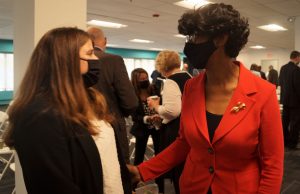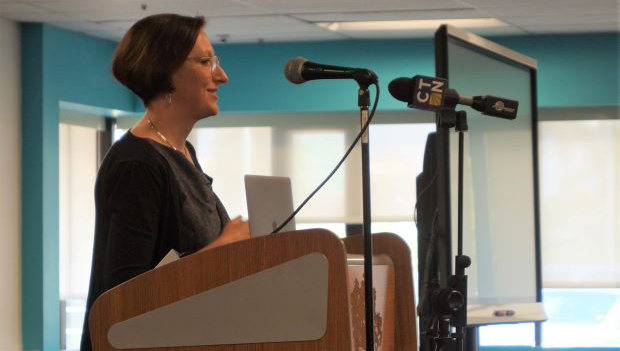The State Department of Education (SDE) usually holds an annual back-to-school meeting for superintendents in August, and after a hiatus last year due to the pandemic, superintendents, SDE staff, and other education stakeholders were in-person again today for a masked gathering held at Goodwin University’s Magnet School System in East Hartford.
Although the challenges of a year and a half of pandemic learning are continuing into the 2020-21 school year, there was optimism in the air and several speakers highlighted a silver lining of the pandemic: increased collaboration among stakeholder groups.
In a prerecorded greeting, Governor Lamont, who is vacationing in Maine this week, thanked educators for their work during a difficult year. “We know more than ever how important it is to be in the classroom and do it safely,” he said.
His remarks were followed by video greetings from the commissioners of the Office of Early Childhood and Departments of Public Health and Children and Families.
SDE Acting Commissioner Charlene Russell-Tucker said that the pandemic has highlighted the need for intentional state agency collaboration.
She compared the perseverance, dedication, patience, and resilience of Connecticut educators during the pandemic to that of Olympians who have recently excelled on a national stage. “The effort required of all of you in the education community this year is as inspiring as the work of our Olympians,” Russell-Tucker said.

CEA Vice President Joslyn DeLancey and SDE Acting Commissioner Charlene Russell-Tucker greet one another at the SDE’s annual back-to-school meeting.
She acknowledged the many uncertainties and concerns that still surround the upcoming school year and emphasized that the health and safety of school communities remains front and center. “We are here for you,” she told superintendents.
Fran Rabinowitz, executive director of the Connecticut Association of Public School Superintendents (CAPSS), said that the partnerships and regular conversations among superintendents as well as with the SDE and among education stakeholder groups have been a bright spot during the incredible difficulties of the last year and a half.
Mentioning frequent meetings with the SDE and between CAPSS, CEA, AFT-Connecticut, the Connecticut Association of Boards of Education, and the Connecticut Association of Schools, Rabinowitz said, “I hope we continue to have these ongoing, wonderful conversations.” She added, “I’m hearing perspectives I did not hear previously, and I’m grateful for that.”
Tackling Tricky Conversations
Dr. Julia Minson (pictured at top of page), a professor at the Harvard Kennedy School, gave the event’s keynote on the science of conversation—a timely topic for superintendents as they respond to questions and concerns from parents in the lead up to the 2020-21 school year.
Minson explained that conversations are ubiquitous but also incredibly complex. “Conversation is complex partly because people have lots of goals for their conversations that they often don’t think about,” she said. In addition to information sharing and collaboration goals, people also have individual, and sometimes selfish goals for conversations that don’t match their conversation partner’s goals.
Frequently in conversations, Minson said that parties come away feeling that they wished the other person would understand them better. How to show a conversation partner that we’re truly listening and get them to listen to us can be a challenge.
Additionally, when it comes to discussing difficult topics, Minson said people tend to exaggerate the amount of disagreement between themselves and others who think differently on a given topic. For example, research shows that Democrats think Republicans hold more extreme views on many issues than Republicans actually do, and Republicans think likewise about Democrats.
We know when a person we’re talking to makes us feel heard and when they don’t, but what is it about their response that makes a difference? Minson and her students have delved into the topic, studying people’s reactions to others’ responses and coming up with an algorithm showing the factors that make the biggest difference in whether a person feels their conversation partner is engaged with their perspective.
The acronym for these factors, a receptiveness recipe, is HEAR, which stands for Hedge your claims, Emphasize agreement, Acknowledge other perspective, and Reframe the positive.
Hedging your claims means being humble and letting the other person know you know you don’t have all the answers. Even people with strong opposing views have some areas of agreement. Emphasizing that shared common ground will let the other person know you recognize that they have something valuable to say. Acknowledging another person’s point of view can mean saying “I understand you’re saying . . .” or “I think you mentioned . . .” and deliberately showing that you heard what your counterpart said. Reframing the positive is a reminder to be mindful to use positive language and focus on the benefits in any given situation.
“When you just tell people to be open minded, they don’t know how to show it—they revert to politeness and formality,” Minson said, “but when you call me ma’am it doesn’t actually make me feel heard.”
The behaviors associated with the HEAR acronym will make your partner feel heard, and, since language has incredibly strong norms of reciprocity, Minson said that you can begin a positive conversational spiral where you can lead by example.
“When you express receptiveness, it’s more persuasive than straight up arguing,” Minson said.
Practicing phrases that align with the HEAR acronym is a concrete way to let people know you hear them, and Minson adds, “Having the right words for these situations on the tip of your tongue prevents unforced errors.”
Learn more about Minson’s work at juliaminson.com and receptiveness.net.
You can watch the entire State Department of Education back-to-school meeting here.







